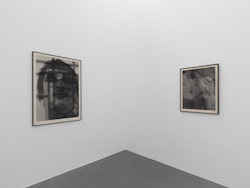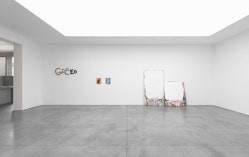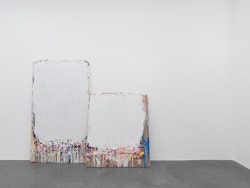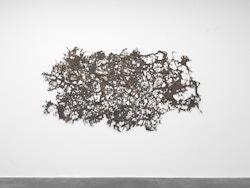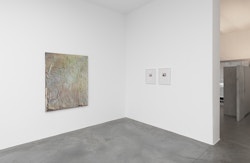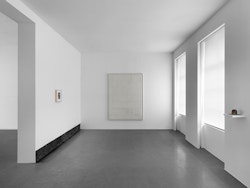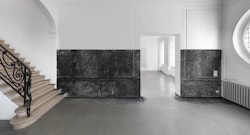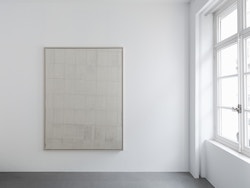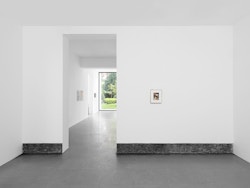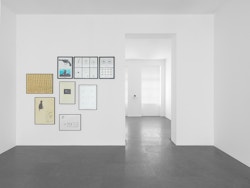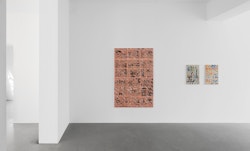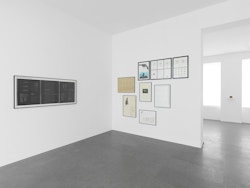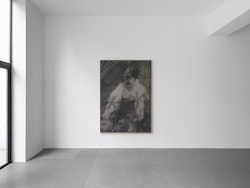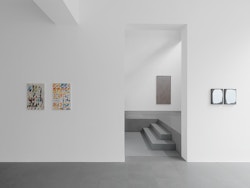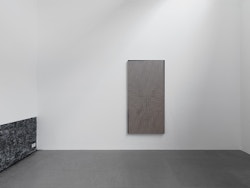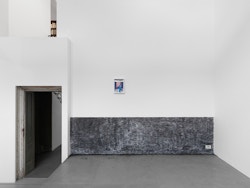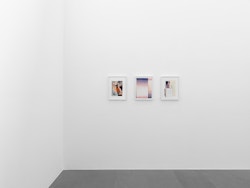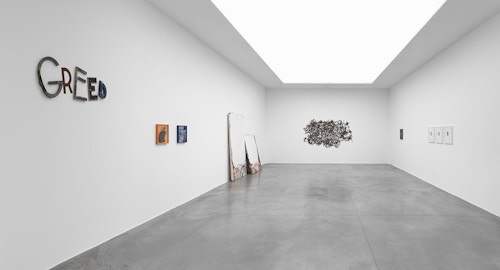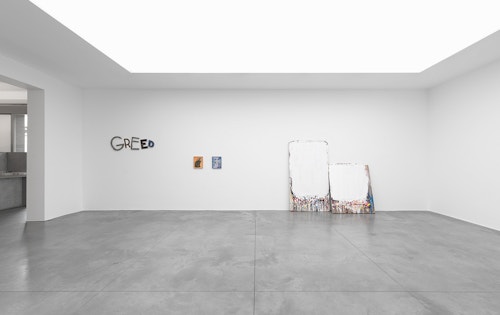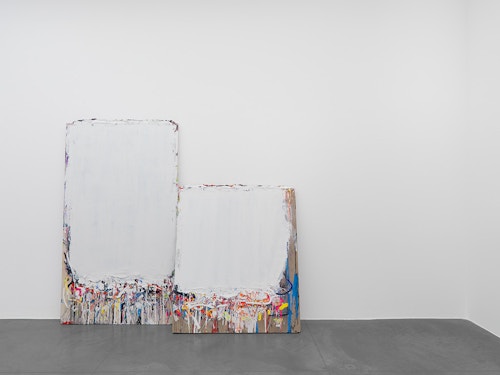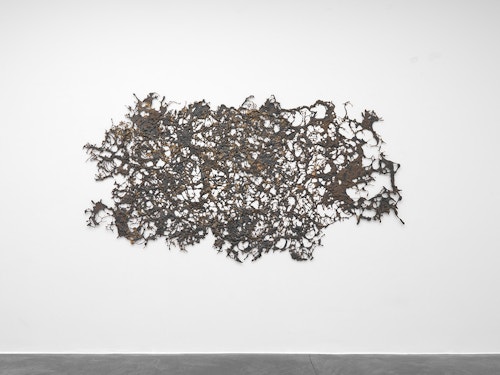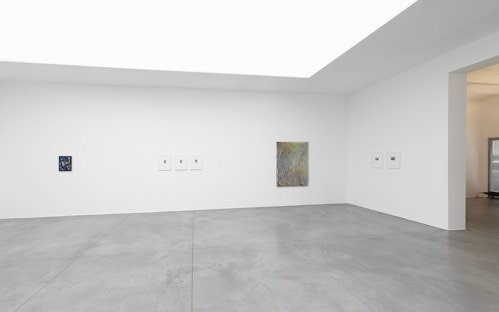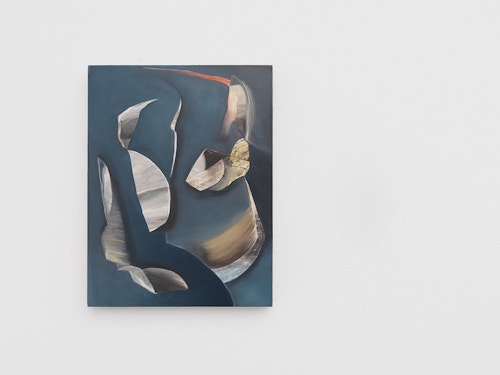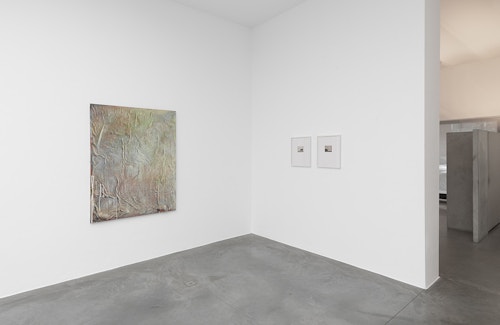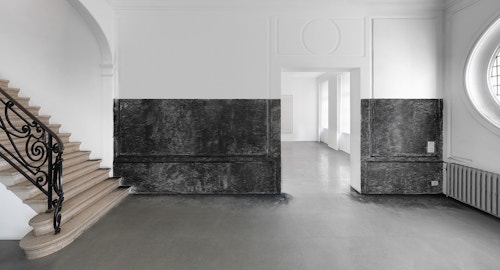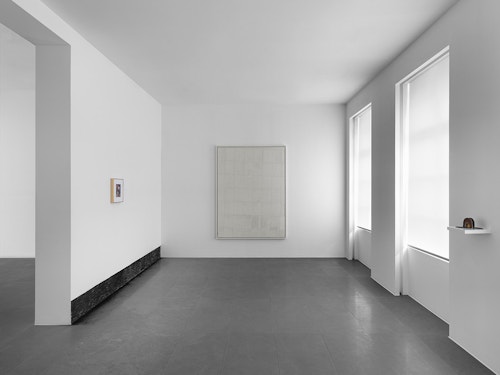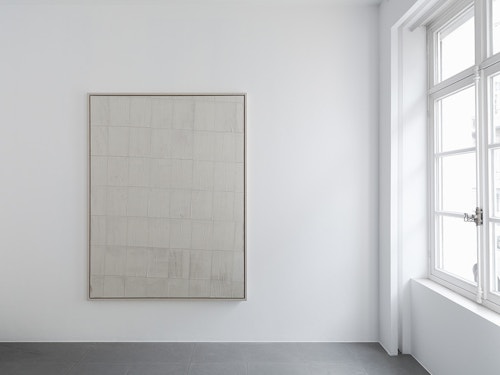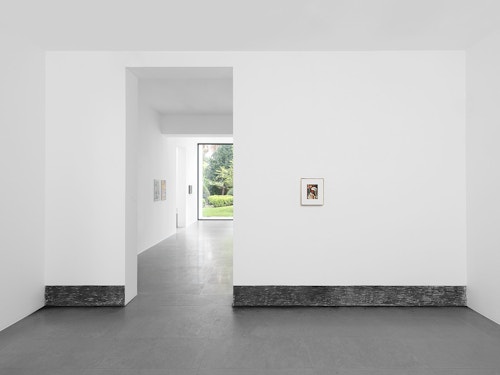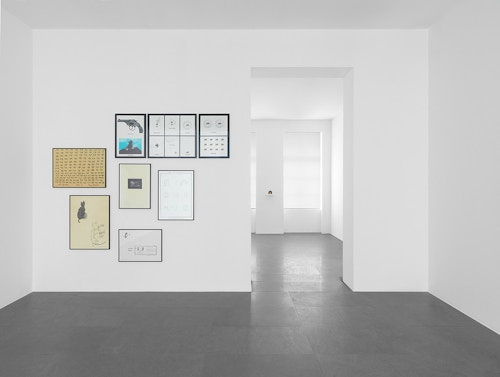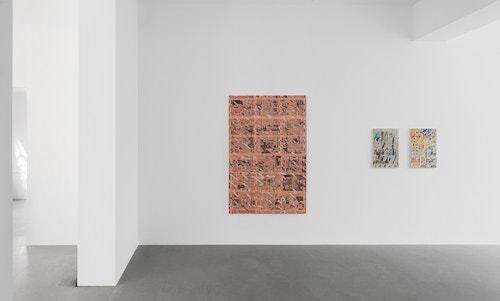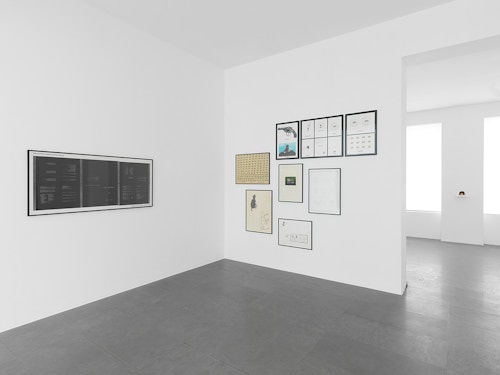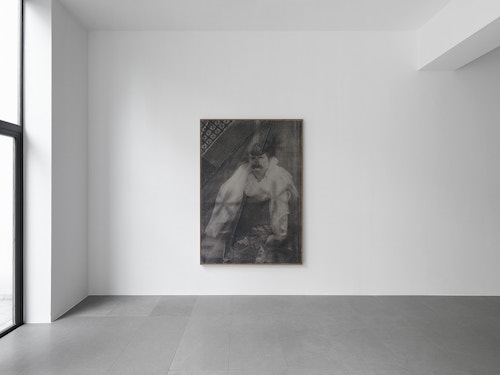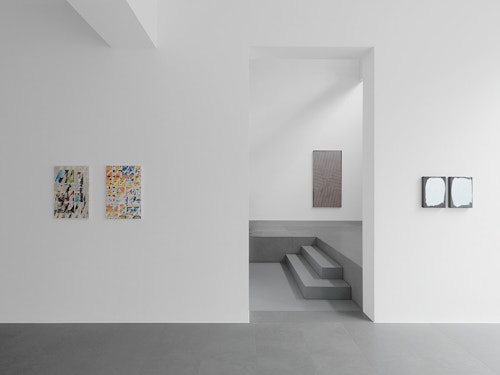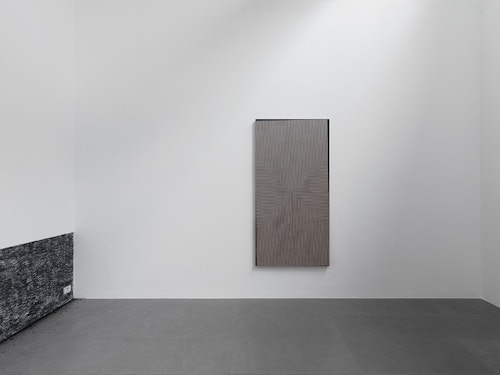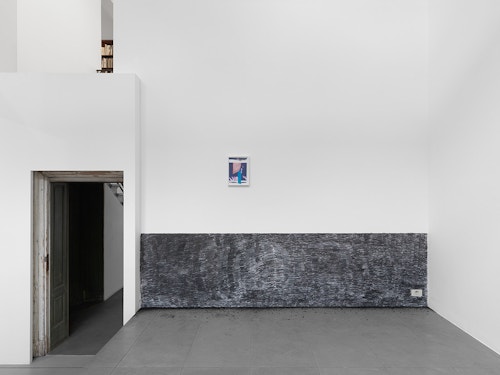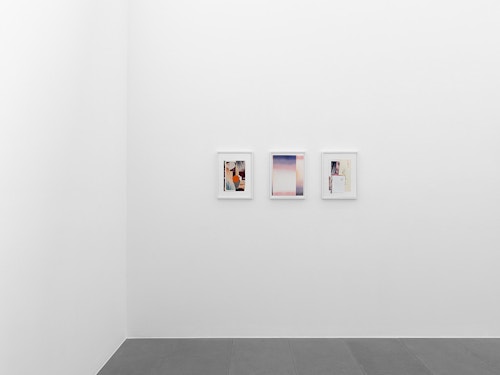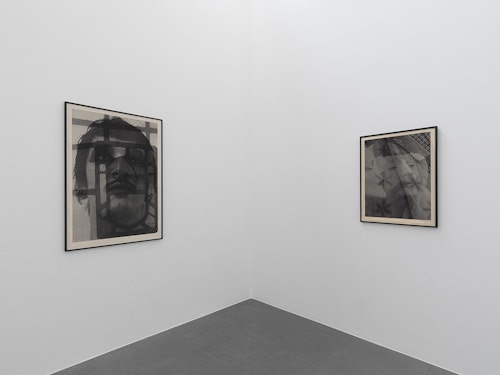
Group Exhibition Everything You Can Imagine Is Real…
Everything You Can Imagine Is Real…
Group exhibition including David Altmejd, Marcel Broodthaers, Andrew Dadson,Latifa Echakhch, Michel François, Nikolas Gambaroff, Vincent Geyskens, Jacob Kassay, Elad Lassry, Robert Mapplethorpe, Ron Nagle, David Noonan, Jack Pierson, Ryan Sullivan, Lesley Vance & Ned Vena

DAVID ALTMEJD (Canada, 1974) lives and works in New York. Altmejd is known for his human- oid figures and complex display cases of platform-style structures in which he arranges strange, seductive and grotesque objects, for example pieces of crystal, fantasy jewellery and sculpted werewolf parts. These ephemeral, organic images embody ideas of transformation and development and simulate a manifestation of energy via the physical aspects of the materials. His work has been shown at the New Museum, the Guggenheim Museum and MoMA/PS1 in New York.
MARCEL BROODTHAERS (Belgium, 1924-1976) was a poet, filmmaker and artist with a highly literary and often witty approach to creating art. His work was characterized by reflections on the essence of art, the artist, the museum, the signature, uniqueness and reproducibility, and the context in which the work operates. His conceptual projects often resulted in printed works such as editions and artist’s books.
ANDREW DADSON (Canada, 1980) lives and works in Vancouver. Dadson combines strong concep- tual ideas with highly imaginative object making. His work develops the idea of the action repeated in time, questioning the concept of limit and physical space. In his paintings he exceeds the two-dimensional plane of the canvas to create a sculptural relationship with space. Dadson’s so-called ‘Lean Paintings are protruding from the wall into space, causing a visual distortion which makes their square or rectangular shape look trapezoidal. Leaning against the wall as props, these paintings refer to the work of Richard Serra and Charles Ray, while their monochrome surfaces hark back to the experiences of American abstraction, to artists such as Rauschenberg, Reinhardt and Rothko.
LATIFA ECHAKHCH (Morocco, 1974) lives and works in Switzerland. In her installations and video works, she critically examines socio-political issues brought about by globalisation, the way national symbols are used, as well as cultural differences and social phenomena. At once poetic and political, the artist removes objects from their daily use, thus deconstructing the social codes resonating within them. Her work has been shown at Tate Modern in London, Kunsthalle in Basel and MACBA in Barcelona. Echakhch will be part of ILLUMInations curated by Bice Curiger during the next Venice Biennale.
MICHEL FRANÇOIS (Belgium, 1956) lives and works in Brussels and Paris. François’ work represents both industrial strength and sublime fragility, so as to consistently explore the potential offered by each material in terms of space, volume and balance. This oscillation between extremes – inside/outside, humble/luxurious, intimate/public – questions the formal rhetoric of the classical genre of sculpture. Recently he has had solo exhibitions at the Institut d’Art Contemporain Villeurbanne, SMAK in Ghent and at the Musée des Beaux-Arts in Lausanne.
NICOLAS GAMBAROFF (Germany, 1977) lives and works in New York. Gambaroff exploits the medium of painting as a physical and theoretical support in order to question artistic authorship, display, distribution and reception. He analyses the social and economic value of painting and the different processes of its construction, questioning old and new myths of artistic production. By repeating the gesture of a signa- ture or abstracted script across multiple canvases, incorporating newspapers and found objects, the artist’s mark is demystified and rendered as a meaningless action and hollow sign. Gambaroff’s work has been shown in exhibitions at the Sculpture Center and the New Museum in New York.
VINCENT GEYSKENS (Belgium, 1971) lives and works in Brussels. Although heterogeneous, Geyskens’ oeuvre continuously researches the formal foundations of painting and its difficult position in con- temporary society. His collages reveal their contrary, sometimes raw, and often inappropriate sensuality through the use of a wide range of materials. Tears, scratches, spray trails, folds, etc. build the work up and, at the same time, expose it. This leads to themes such as: skin, fascism, infection, eroticism, artificial light, pornography, androgyny, the body as experiment and myth, visual culture as the original of a double-entendre fiction. Geyskens’ work has recently been shown at Wiels in Brussels and is part of the collection of SMAK in Ghent.
JACOB KASSAY (USA, 1984) lives and works in New York. Kassay’s work is concerned with the experience of being in a room with a painting. The shimmering silver surfaces of his canvases transform blankness into aura and emptiness into reflection. His paintings function as objects in space, taking on all the lights, shadows, colours, and images of their surroundings. Their silver reflection is obtained by submitting the canvas to photographic processes. Kassay uses an electroplater – commonly used to create silver surfaces on jewellery or silverware – for fixing a metallic layer to the primed canvas. This chemical process leaves behind burn marks around the edges of the silver paintings. Jacob Kassay has recently shown at Collezione Maramotti in Italy and he will present a solo project at Art Unlimited during Art Basel 2011.
ELAD LASSRY (Israel, 1977) lives and works in Los Angeles. Throughout his oeuvre, Lassry explores the status of the picture today by opposing pictorial realms of the analogue and the digital to create a tension that unfolds within the photographic space. His staged photographs are collages of images which the artist disconnects from their existing visual history, thus negating origin, authorship and intentionality and compelling the viewer to consider a new conceptual space for the picture. Solo exhibitions of Lassry’s work were recently presented at The Whitney Museum in New York and The Art Institute of Chicago. He was also featured in the group exhibition New Photography 2010 at the MoMA in New York.
ROBERT MAPPLETHORPE (USA, 1946-1989) was one of the most controversial and influential photographers of his time. Mapplethorpe took his first photographs using a Polaroid camera for Andy Warhol’s magazine, Interview. Turning to full-time photography in the mid 1970s, he acquired a Hasselblad camera and began taking photographs of a wide circle of friends and acquaintances, including artists, composers, and socialites. In the 1980s he refined his aesthetic, photographing statuesque male and female nudes, delicate flower still lifes, and highly formal portraits of artists and celebrities. Mapplethorpe’s choices were both innovative and bold. His cutting-edge use of homoerotic and other challenging themes has become embedded in our culture and his work has continued to resonate after his early death in 1989.
RON NAGLE (USA, 1939) lives and works in California. Nagle is one of the premier ceramic sculp- tors working today in the United States. Known for an obsessive attention to detail and finish and a colourful Californian palette, Nagle’s sculptures, often on an intimately small scale, testify of the artist’s relentless love of pop culture and his art-historical wit. He has devoted his career to elevating and redefining the art form of ceramic sculpture. His work has recently been shown at the Institute of Contemporary Art of Philadelphia, the Museum of Fine Arts in Houston and the Metropolitan Museum of Art in New York.
DAVID NOONAN (Australia, 1969) lives and works in London. Noonan depicts a universe inspired by theatre, ancient rituals and folk mythology, and the sinister world of the occult. His human figures are visible only partially, hanging out of time, place or specific colour. Costumes and masks hide their real character. Despite this dark mood, there is a delicate and poetic sensibility to Noonan’s work that uses slips and accidents of memory to offer a captivating anonymity. His paintings disorient the viewer by the sight of fragile bodies carrying blind rituals. The texture of Noonan’s photographic prints and silkscreen prints on linen grants them a sculptural dimension. Noonan had solo exhibitions at the Palais de Tokyo in Paris, the Australian Center for Contemporary Art in Melbourne and the Chisenhale Gallery in London.
JACK PIERSON (USA, 1960) lives and works in New York and California. Pierson’s broad range of photographs, drawings and installations deal with themes like memory, melancholy, sex, fame, loneliness and the passage of time. The artist’s most well-known works are his word sculptures, composed of metallic letters from old signs that he has acquired by rummaging through flea markets. These words have a potent evocative power, permitting the spectator a very personal interpretation. Pierson has exhibited widely in both Europe and America. He had important solo exhibitions at the Museum of Contemporary Art in Miami and at the Centre d’Art Santa Monica in Barcelona in 2007. A retrospective exhibition of his oeuvre was held at the Irish Museum of Modern Art in Dublin.
RYAN SULLIVAN (USA, 1983) lives and works in New York. Sullivan’s painting makes use of observed and absorbed visual phenomena in order to negotiate the inherent action and chemistry of painterly materials. Not interested in depiction or orchestrated abstraction, these assimilated influences run parallel to the work, interpreted as the ‘resonance of the world.’ Sullivan’s works are rooted in the alchemy and accident of process. His work has recently been shown at MoMA/PS1 in New York.
LESLEY VANCE (USA, 1977) lives and works in Los Angeles. Vance’s relatively small canvases are visual, philosophical and historical inquiries into the still life genre, although they become abstract works. Vance explores through her abstract paintings the material aspects of the studio process, reflecting upon luminosity, shadow and weight. Her practice reflects the possibility of ongoing formal innovations within the medium of painting. Vance’s work has been shown at the Whitney Biennial in New York and LACMA in Los Angeles.
NED VENA (USA, 1982) lives and works in New York. Vena’s work investigates the alchemy of material processes. He lays vinyl stencils on a raw linen canvas before ‘painting’ over the surface with aerosol spray rubber. Once dried, the vinyl is removed but not without leaving traces. This ‘bruising’ gesture moder- ates a discussion of the artist’s hand incised by mechanized processes and prioritizes the ghosting left under- neath the patterns. Vena articulates an interest in elements of commercial signage and an abstraction of language. The use of lines is informed by a minimalist discourse, exploring relations with Frank Stella’s Black Paintings. Vena’s work has recently been shown at Midway Contemporary Art in Minneapolis, the Kunstverein in Freiburg and the Kestnergesellschaft in Hannover.
